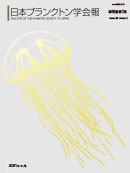Volume 68, Issue 2
Displaying 1-10 of 10 articles from this issue
- |<
- <
- 1
- >
- >|
-
2021Volume 68Issue 2 Pages 35
Published: August 25, 2021
Released on J-STAGE: September 02, 2021
Download PDF (160K)
Original Papers
-
2021Volume 68Issue 2 Pages 36-45
Published: August 25, 2021
Released on J-STAGE: September 02, 2021
Download PDF (945K) -
2021Volume 68Issue 2 Pages 46-57
Published: August 25, 2021
Released on J-STAGE: September 02, 2021
Download PDF (1296K)
Prize of the Plankton Society of Japan
-
2021Volume 68Issue 2 Pages 58-59
Published: August 25, 2021
Released on J-STAGE: September 02, 2021
Download PDF (401K) -
2021Volume 68Issue 2 Pages 59-60
Published: August 25, 2021
Released on J-STAGE: September 02, 2021
Download PDF (233K)
Book Review
-
2021Volume 68Issue 2 Pages 61-62
Published: August 25, 2021
Released on J-STAGE: September 02, 2021
Download PDF (186K) -
2021Volume 68Issue 2 Pages 62-63
Published: August 25, 2021
Released on J-STAGE: September 02, 2021
Download PDF (180K)
Abstracts of Original Papers on Plankton & Benthos Research
-
2021Volume 68Issue 2 Pages 64-65
Published: August 25, 2021
Released on J-STAGE: September 02, 2021
Download PDF (191K)
-
2021Volume 68Issue 2 Pages 66-69
Published: August 25, 2021
Released on J-STAGE: September 02, 2021
Download PDF (206K) -
2021Volume 68Issue 2 Pages 70-76
Published: August 25, 2021
Released on J-STAGE: September 02, 2021
Download PDF (267K)
- |<
- <
- 1
- >
- >|
